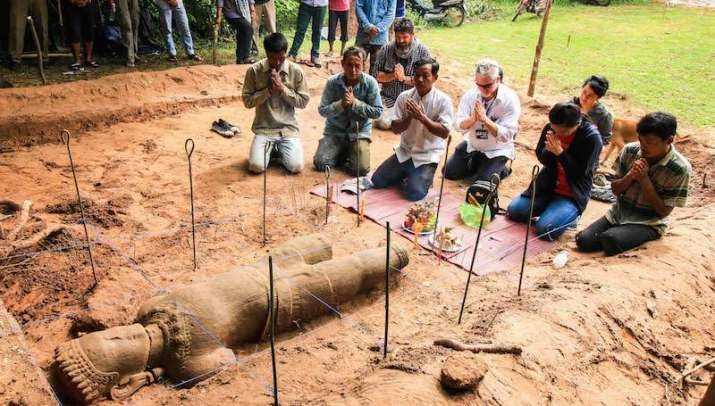
By Shyamal Sinha

The Angkor Archeological Park, a world heritage site, contains the remains of the different capitals of the Khmer Empire, dating from the 9th to the 15th centuries, and is Cambodia’s most popular tourist destination.
A team of archaeologists excavating an 800-year-old site in Cambodia’s famed Angkor Archaeological Park have unearthed fragments of a rare Medicine Buddha carving and a two-meter-tall guardian statue that they believe date back to the 12th century. The Cambodia Daily newspaperdescribed the unexpected discoveries as “like something that only happens in the movies.”
The 13-day excavation near the northern entrance to the former imperial capital of Angkor Thom, which wrapped up last week, yielded a veritable treasure trove of ancient artifacts from the grounds of a hospital built by King Jayavarman VII (r. c.1181–1218). Alongside the rare statues, the archaeologists also discovered traces of smelting, which might have been for bronze casting, as well as porcelain, roof tiles, and Khmer and Chinese ceramics.

Covering an area of some 400 square kilometers in Cambodia’s northern province of Siem Reap, Angkor Archaeological Park is one of the most important archaeological sites in Southeast Asia, containing the remains of several capitals of the Khmer empire that flourished from the 9th–15th century—among the landmarks the celebrated Angkor Wat complex. A protected UNESCO World Heritage Site, the area also includes Angkor Thom, the last and most enduring capital of the Khmer empire. At its height, the city complex and hundreds of temples were home to more than a million inhabitants, making it one of the most populated pre-industrial centers in history. Large areas of the park have been excavated over the decades, creating an immersive archaeological wonder that draws more than 2 million visitors each year.
The researchers said the recently unearthed two-meter sandstone figure likely depicts a guardian deity that stood at the entrance to an ancient hospital.
“Jayavarman VII’s reign was truly remarkable in terms of social programs,” said Tan Boun Suy, deputy director-general of the Apsara Authority, the government agency that manages Angkor Archaeological Park and is conducting the excavation. “The hospital consisted of wooden buildings and a chapel erected in stones. What is left is the chapel . . . as wooden structures have long disappeared.” (The Cambodia Daily)


Found buried just 40 centimeters below the surface of the ground and weighing about 200 kilograms, the statue is missing both feet, with the right leg ending just before the ankle and the left leg near the bottom of the thigh. Both arms are missing just below the shoulders. However, the Apsara Authority said the body and head remained well preserved. Im Sokrithy, the dig’s scientific supervisor, observed that had the figure been whole, it would have stood at least 2.1 meters tall.
“Door guardians were symbols of protection,” said Apsara Authority spokesman Long Kosal. “The guardians used to stand in front of the doors of the temples or other ancient places.” (The Phnom Penh Post)
The second major find at the excavation were fragments of a Medicine Buddha. Although inscriptions from the era note that a Medicine Buddha image stood in the chapel of every Jayavarman VII hospital, this is the first example that has ever been found.

“This truly is a find,” said Tan Boun Suy, adding that the hospital is believed to be one of 102 that the 12th century king is said to have built throughout his empire. (The Cambodia Daily)
“We identified him because of an object in the palm of his hand . . . whose form is similar to a very small pyramid,” said Im Sokrithy. (The Cambodia Daily)
“With this discovery, we have finally proven that Buddhist medicine was practiced during the reign of Jayavarman VII under the blessing of the Medicine Buddha,” said Dr. Rethy Chhem, an authority on Angkorian hospitals and medicine, and an adviser on the dig. “I had said we would hit gold if we found the statue of the Buddha,” he added. “This is it, we hit gold.” (The Cambodia Daily)
The Apsara Authority, which has been working with experts from Singapore’s Institute of Southeast Asian Studies, said the discoveries would be placed on public exhibition in the nearby Preah Norodom Sihanouk-Angkor Museum.
The Apsara agency said the sandstone statue’s arms and legs had broken off but the carving on the body and head “remain beautiful” despite the passage of time.
They said the statue was likely to have been a symbolic guardian of the hospital.












